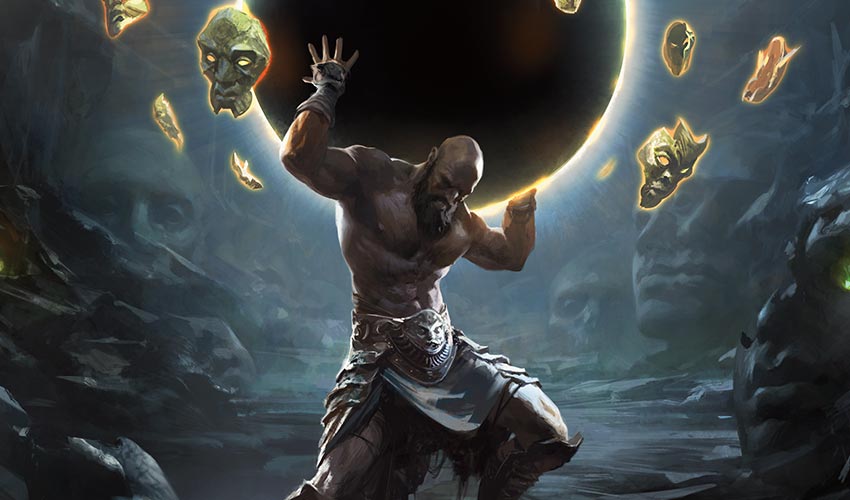The Meaning of Pain
Last week, we took a look at the bright side of life: life gain.
We talked about when life gain cards are worth playing, what their strengths are, and what matchups they can be good—or bad—in.
But the entire picture isn't quite complete without dipping our toes into the murky waters of life loss. It's a plunge into the sinister world of cards that ask for you to pay your life for their effects. When are these worth it?
Well, hold your breath and snap on your goggles, because we're diving in!

In Magic, you start with the cards in your hand and your library as resources. These are the tools that are going to help you win the game.
But there's another crucial resource you have at your disposal: your life total.
It's easy to look at life totals as a way to see who is winning or losing. As simply a metric. But a life total is far more than that: your life total is a resource.
If you're playing a slow control deck or a combo deck, your life total might be the resource buffer you have against the beatdown deck across the table. You can take some knocks from some creatures because you have plenty of life to play with, and your life is a resource.
Similarly, you can use it to help cast your spells and make your chances of winning improve.
Let's take a look at a card that has shown up plenty during its time in Standard:
Anguished Unmaking gets rid of almost anything for just three mana! That's a great price considering that it plucks planeswalkers, creatures, and enchantments into exile all the same.
The cost outside of just the mana, of course, is the 3 life you pay on top of it. You definitely don't want to just lose 3 life over and over again—your life total is a resource, but you have to wonder: is this card really worth it over another removal spell?
And yet, this is a fairly strong card. Why is that?
Let's investigate.
One Life to Live
I don't know who said it first, which Magic scribe etched it into the tomes of history before another did. But there's an important sentiment that is crucial to understanding a wider range of Magic.
If there is one thing that you take away from this article, it's this: The only point of your life total that matters in Magic is the last one.
That's right. Those first 19 life points? All just a resource, as described earlier. They're just shields, protecting you from the spear-through-the-heart of the loss of your final life point. Losing them is fine.
It's easy to have the knee-jerk reaction of "you don't want to lose life." But often, paying some life in the short term can help you save life in the long term!
Let's go back to Anguished Unmaking.
If your opponent has a 5/5 creature that's going to hit you and you spend an Anguished Unmaking on it, you actually just saved yourself life points in the process.
Now, it's true that you could have used a different removal spell there that didn't make you lose 3 life—and what you're really paying for is the flexibility. What if that 5/5 creature was, instead, a Chandra, Torch of Defiance? You're going to lose 3 life, but you wouldn't have been able to deal with it otherwise.
Remember: your life total is a resource, and the only point that matters is your last one. If using Anguished Unmaking means you weren't going to be in a spot where that 3 life was likely to matter (even if you end up losing, unless you lose by 3 or less life, you were going to lose anyway), then you haven't really paid a significant cost at all.
. . . Or, at least, that is, sometimes.
Death by Numbers
How much life payment matters depends a lot on how much you're paying and at what stage during the game it happens.
For example, if you look at the fetch lands like Flooded Strand and Verdant Catacombs—staples of older formats—they all cost you 1 life to use. Yet, decks will fill up with tons of these. Why is that?
Paying 1 life is nearly free. The chances 1 life is going to be the difference between winning and losing, while it can happen, are low. Often, you were going to win or lose regardless of that 1 life.
Additionally, in this particular example, the fetch lands significantly fix your mana early game—which means you can play stronger early game spells. The 1 life here is absolutely reasonable because it helps your entire deck function to a better capacity. In fact, many decks will toss away 5-plus points of life over the course of a game to make their mana work simply because it's well worth the life you pay.
But there is something to watch out for here. And that's about the weight of too many life loss cards.

Let's say your lands are dealing you damage. And you also have some cards like Anguished Unmaking. And then you load up on a few cards like Painful Truths. Before you know it, you're regularly dealing yourself 8-plus damage a game—and that definitely can matter in a big way!
You have to be very careful about compounding too many life-payment cards into one deck. At some point, unless you have life gain to pair with it, you're very likely going to end up with cards you can't cast—and then the advantage you got from skirting costs by paying life instead is significantly dampened, as you have multiple cards rotting away in your hand.
This is why, while Anguished Unmaking has shown up in a fair number of decks, you often see one, two, or sometimes three copies instead of four. The first Anguished Unmaking you draw is usually good—but drawing too many of them can kill you or result in cards you can't cast.
Matchup Matters
The matchup you're playing also really matters when it comes to how much life payment can be okay.
In a control mirror match, you can often pay life with little regard for the results. I've taken damage from putting my Hallowed Fountains onto the battlefield untapped just to bluff cards more times than I can count. This is the matchup where you can fire off all the Painful Truths for three cards you want and you're likely going to be okay until you're at the point where you would either certainly win or lose anyway.

Conversely, if you're playing against a red burn deck, then cards that deal damage to you become a lot less attractive. Your Painful Truths suddenly becomes a Lava Spike you cast for them for free!
There are exceptions, of course—cards like Dark Confidant and Asylum Visitor can still be quite good against aggressive decks, because you want the extra cards to take the upper hand in the game and they're creatures you can attack and block with. Bitterblossom loses you 1 life each turn, but considering it can block creatures into perpetuity, often it's functionally gaining you life!
It is not just about checking the game text for losing life, but also examining the manner in which you are losing life and whether it's worth it here.
Live Long and Prosper
Hopefully you enjoyed this look at losing life! It's not always quite as scary as it looks.
Between this week and last week's discussion of gaining life, you now have a big picture look at what makes both life gain and life loss tick—and how you might be able to build decks using them in unison!
There may still be some lingering questions—and if so, I'm always happy to hear from you! If you have any questions or thoughts, please, feel free to fire them my way. You can always reach me on Twitter, Tumblr, or via e-mail (in English) at BeyondBasicsMagic@gmail.com.
I'll talk with you again next week. Until then, have fun paying life!

